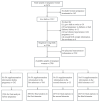Placenta-Related Parameters at Delivery in Relation to Folic Acid Supplementation in Different Pregnancies
- PMID: 38892661
- PMCID: PMC11174953
- DOI: 10.3390/nu16111729
Placenta-Related Parameters at Delivery in Relation to Folic Acid Supplementation in Different Pregnancies
Abstract
Folic acid plays an important role in the synthesis, repair, and methylation of deoxyribonucleic acid (DNA). Currently, most studies have focused on the effects of periconceptional folic acid (FA) supplementation on fetal development, and there is still a lack of population-based research exploring the association between FA use during pregnancy and placental development. This study aimed to investigate the impacts of FA supplementation in different pregnancies on placenta-related parameters at delivery. The study included 2708 pregnant women recruited from Ma'anshan City, Anhui Province, China, between May 2013 and September 2014. Information on FA use from one month before conception to delivery was collected. Placental length, width, and thickness were measured. Multivariable logistic regression analysis was used to assess the effects of FA supplementation in different pregnancies on placenta-related parameters. Based on multiple regression analysis, propensity score weighting was adopted to enhance comparability between different FA supplementation groups. Compared with FA non-users, FA supplementation before conception was associated with increased placental width (0.241 cm, 95%CI: 0.052-0.429, p = 0.013) and increased placental surface area (6.398 cm2, 95%CI: 1.407-11.389, p = 0.012), and FA use in early/middle pregnancy was, respectively, related with increased placental thickness (0.061 cm, 95%CI: 0.004-0.117, p = 0.036; 0.066 cm, 95%CI: 0.004-0.129, p = 0.038). FA use before conception could increase placental width and area, and FA use in early/middle pregnancy could increase placental thickness. To confirm the findings, further investigations are needed.
Keywords: China; folic acid; placenta; pregnancy.
Conflict of interest statement
The authors declare no conflict of interest.
Figures
Similar articles
-
Maternal Continuing Folic Acid Supplementation after the First Trimester of Pregnancy Increased the Risk of Large-for-Gestational-Age Birth: A Population-Based Birth Cohort Study.Nutrients. 2016 Aug 15;8(8):493. doi: 10.3390/nu8080493. Nutrients. 2016. PMID: 27537908 Free PMC article.
-
Folic Acid Supplementation in Chinese Peri-conceptional Population: Results from the SPCC Study.Biomed Environ Sci. 2020 Aug 20;33(8):557-565. doi: 10.3967/bes2020.074. Biomed Environ Sci. 2020. PMID: 32933607
-
Dietary Folic Acid Supplementation Attenuates Maternal High-Fat Diet-Induced Fetal Intrauterine Growth Retarded via Ameliorating Placental Inflammation and Oxidative Stress in Rats.Nutrients. 2023 Jul 24;15(14):3263. doi: 10.3390/nu15143263. Nutrients. 2023. PMID: 37513681 Free PMC article.
-
Placental Impact of Dietary Supplements: More Than Micronutrients.Clin Ther. 2021 Feb;43(2):226-245. doi: 10.1016/j.clinthera.2020.11.017. Epub 2020 Dec 23. Clin Ther. 2021. PMID: 33358257 Free PMC article. Review.
-
The impact of periconceptional maternal lifestyle on clinical features and biomarkers of placental development and function: a systematic review.Hum Reprod Update. 2019 Jan 1;25(1):72-94. doi: 10.1093/humupd/dmy037. Hum Reprod Update. 2019. PMID: 30407510
Cited by
-
Nutraceuticals in Pregnancy: A Special Focus on Probiotics.Int J Mol Sci. 2024 Sep 7;25(17):9688. doi: 10.3390/ijms25179688. Int J Mol Sci. 2024. PMID: 39273635 Free PMC article. Review.
-
First-trimester maternal folate and vitamin B12 concentrations and their associations with first-trimester placental growth: the Rotterdam Periconception Cohort.Hum Reprod. 2025 Aug 1;40(8):1485-1494. doi: 10.1093/humrep/deaf095. Hum Reprod. 2025. PMID: 40373185 Free PMC article.
References
MeSH terms
Substances
Grants and funding
LinkOut - more resources
Full Text Sources
Medical


